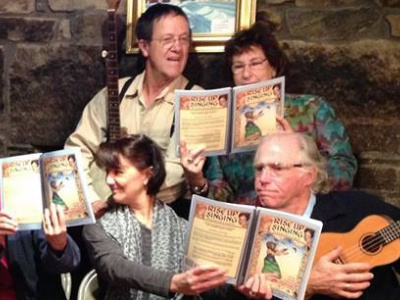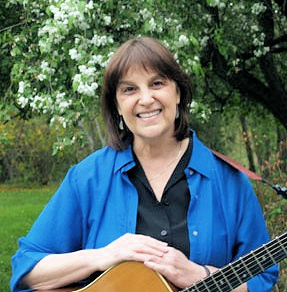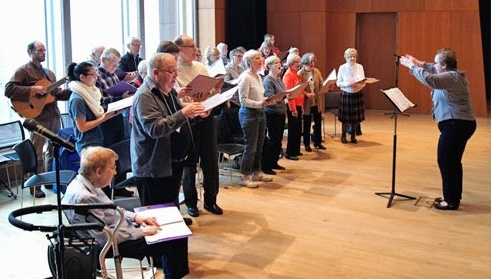
Choruses and Song Swaps
A Way to Bring Singing Into Our Communities
by Sally Rogers
We lost America’s greatest song leader in January 2014 when Pete Seeger died at the age of ninety-four. Pete dedicated his life to getting people to join in community, find their voices, and sing out loud, proud, and strong. His grandson, Tao Rodriguez-Seeger said, “He genuinely believes that through the communal experience of music, people and the world will be made better” (Alarik 2005). In the process, he inspired thousands of people to pick up a guitar, banjo, or ukulele, or sit down at a keyboard and sing with their friends and neighbors. Upon his passing, many community singing groups were established simply for the joy of singing together with friends and neighbors.
Pete Seeger told us…that if this world survives a hundred years from now, it may well be because of people singing together.
—Rise Up and Sing
So where can we go to sing with others besides church? There are opportunities across the nation for us to become inspired to create our own singing communities. Across the country, friends and neighbors host weekly or monthly sings, sing-alongs, and song swaps inspired by the Seeger legacy. Peter Blood and Annie Patterson maintain a list of these sing-along groups on their website, Rise Up and Sing, introduced with the declaration, “Pete Seeger told us a year before he died that if this world survives a hundred years from now, it may well be because of people singing together” (2015). The same site hosts a clearinghouse of sing-along events across the country and in Canada.
 Quiet Corner Song Swap
Quiet Corner Song Swap
Groups like this are more common than you might think. If you visit the Rise Up and Sing website, you will find dozens of singing groups around the country and Canada, and probably one in your own neighborhood. Many of them use Rise Up Singing, the “folk bible” of song lyrics to over 1,200 familiar songs, and the new volume, Rise Again, with 1,200 more songs. Others have participants bring song sheets to share with the group.
 Joanne Hammil
Joanne Hammil
In addition to community sings and song swaps, many new choruses are also growing out of our need as humans to be in community with each other. Some are performance oriented and others address a specific audience of singers. One of the model community choirs in the Boston area is led by CMN member, composer, and music educator, Joanne Hammil. Her intergenerational chorus, whose members range in age from ten years old to folks in their eighties and even nineties, has been going for many years, often with a waiting list. Children and their parents and grandparents come to sing together. One participant says, “It’s the one thing my sixteen-year-old son and I regularly do together—and we both love it!” (Hammil 2015) Similar choruses have sprouted up around the country, including the Intergenerational Outreach Choir (IOC) founded by Crystal Akins, “a family of choirs that currently extends from the Portland metro area to Lincoln City on the Oregon Coast. Choral ensembles include service choirs with residencies in local area nursing or assisted living homes and most recently, in a women’s correctional facility. We also partner with local schools and after‐school programs to provide choral outreach programs for kids and youth” (IOC 2016).
In Minneapolis, the Giving Voice Chorus was established in 2014 for those suffering from Alzheimer’s disease and their caregivers. It has been validated by research that musical memories are the last memories to deteriorate in a patient with dementia. These memories often trigger life memories as well. In Alzheimer’s patients, a trigger often occurs when familiar music or songs are played. According to Michael Thaut, director of the Center for Biomedical Research in Music at Colorado State University in Fort Collins, “When we sing a tune, the right and left hemispheres of the brain are both activated. When we speak, only the left hemisphere is activated. So, if a person suffers a stroke that damages certain areas in the left hemisphere, they can lose the ability to speak. But we can sometimes reactivate speech by teaching them how to sing words” (Young 2015).
 Giving Voice Chorus
Giving Voice Chorus
Founders Marge Ostroushko and Mary Leonard both have dealt with the struggles of caring for a parent with the disease. But both parents loved to sing. Marge and Mary decided that a chorus could help to strengthen these memories and verbal skills while also providing a musical respite for the caregivers. It also would allow couples to spend time together doing something they both love. They currently have seventy-five singers who meet weekly and perform twice a year.
Another type of community singing that has blossomed in the last decade is the Threshold Choir. The movement was founded in 2000 by CMN member, songwriter, and activist Kate Munger in the San Francisco area, and now has over 100 chapters worldwide. Chorus members rehearse regularly, learning to sing a simple, peaceful repertoire. When invited, small groups of three or four member singers gather to sing at the bedsides of those who are “facing death, grief or suffering” (Threshold Choir 2016). Often the groups are involved with local hospice organizations and hospitals.
Groups like these are wonderful resources for our own rejuvenation. We all need to recharge our batteries. Some of us do it by joining groups. Others of us may form our own groups as a way to share our creative energies and raise our voices while involving our community in music beyond the walls of the schoolhouse and religious institutions.
Meanwhile, how do we, as CMN members, encourage community singing in our schools and in our community? Here are a few suggestions:
- Start a daily community sing at your local school. When I taught at Pomfret Community School, we started every day with students coming into the hallway to sing one song together. In this way we built a repertoire of songs that all elementary students knew. The songs can be introduced in the classroom and then live long lives in the hallway!
- Expand your hallway sing into a monthly or bimonthly all-school sing. Bring the whole school into the gym or auditorium to sing for fifteen to twenty minutes. Project the lyrics to songs for all to read, teach the required patriotic songs and anthems, and sing away. Make sure that you are creating a safe place for students to sing and that teachers are also modeling the singing behavior you seek!
- Host an intergenerational sing and potluck in your community, even once a year. If there is food, more people will attend. Rise Up and Sing has great suggestions for making such an event a success.
- Revisit the Get America Singing...Again! list of songs compiled by former National Association for Music Education president Will Schmid and Pete Seeger. Teach them in your classes and use them in your community and school sings.
- Attend a local community sing to feed your own soul. Bring the energy back to your classroom!
- Attend workshops by great song leaders like Nick Page, Isaye Barnwell, and Joanne Hammil. Bring new ideas and material back to your classroom and your community.
There is nothing more empowering than singing together with one voice
We live in a nation where singing has become a commodity rather than a birthright. As singers, songwriters, and teachers, we can return this birthright to those who have lost it, giving them back the power of their own voice. In South Africa, where song is a part of every daily task and ritual, they say, “If you can walk, you can dance; if you can talk, you can sing.” As CMN members, we can make songs spill out of a music room and outward to the community. There is nothing more empowering than singing together with one voice, and we can be at the center of making it happen.